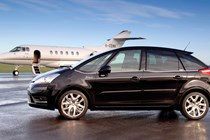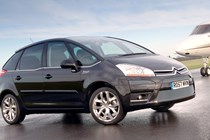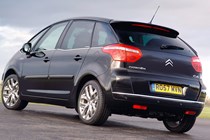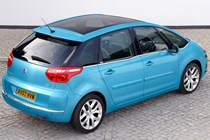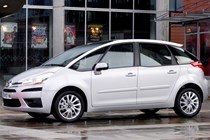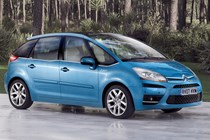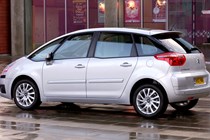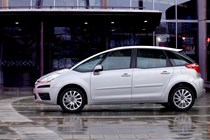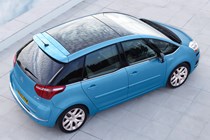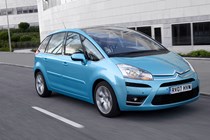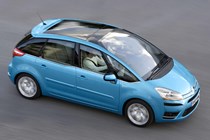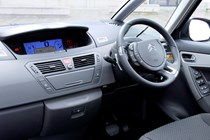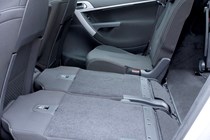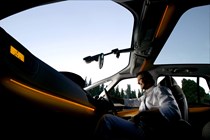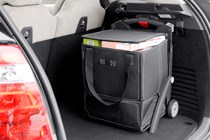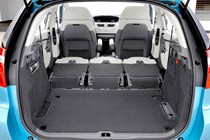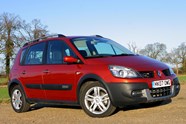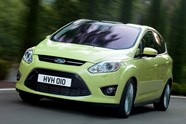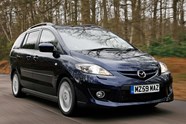
Citroën C4 Picasso Estate (2007-2013) review
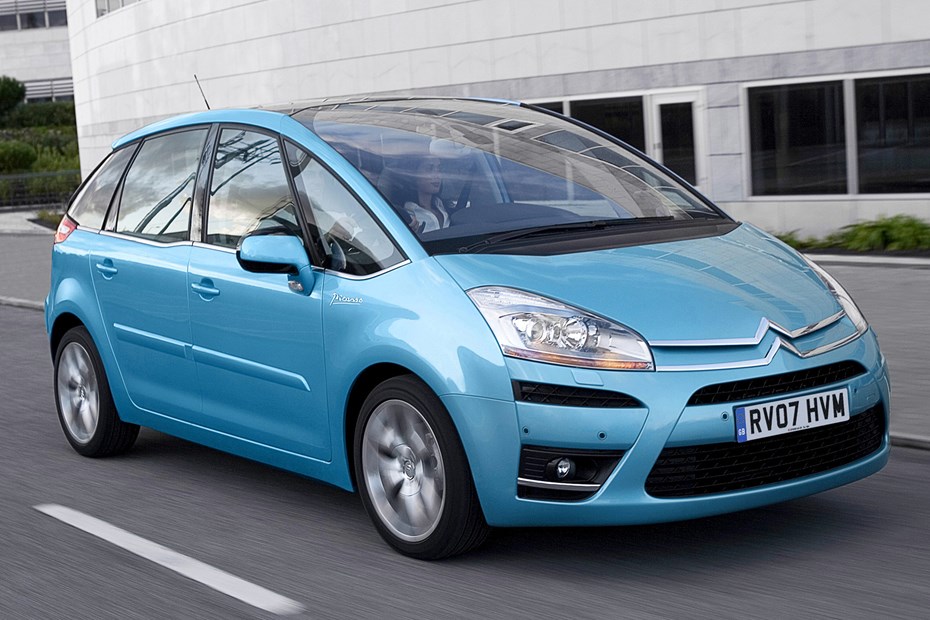
At a glance
| Price new | £13,785 - £23,460 |
|---|---|
| Used prices | £486 - £3,317 |
| Road tax cost | £35 - £430 |
| Insurance group | 12 - 19 |
Get an insurance quote with

|
|
| Fuel economy | Not tested to latest standards |
| Range | 409 - 805 miles |
| Number of doors | 5 |
| View full specs for a specific version | |
Available fuel types
Petrol
Diesel
Pros & cons
- Family-friendly interior
- Sleek styling
- Spacious inside, plenty of storage options
- Entry-level LX doesn't have a stereo
- Jerky automatic EGS gearbox
- Some reliability issues
Citroën C4 Picasso (07-13) rivals
Overview
The C4 Picasso in ‘Grand’ form, initially offering seven seats made its debut at the 2006 Paris motor show. Early in 2007, Citroen launched a cheaper five-seater variant with both models offering a pretty impressive blend of value for money and interior space / flexibility – something French marques are known well for in this sector.
As you would expect, there is a comprehensive range of both petrol and diesel engines, coupled to your choice of manual and automatic gearboxes, to choose from. As this generation was replaced in 2013, the diesel models are not going go be ULEZ compliant so if you want a Picasso in the city, look at the later C4 Picasso Mk2.
One of the features of the car, something you won’t find even on some more expensive rivals, is the oversize panoramic windscreen ensuring a light and airy cabin and expansive view of overhead signs, scenery and sky for drivers as well as passengers. The Zenith windscreen was also used on the smaller C3, but not the DS 3 or related C3 Picasso, and it’s a feature that makes the C4 Picasso feel distinctive and special.
Built in Spain, the C4 Picasso sold extremely well in all three major categories of buyer – company fleet, motability and retail. The typical Citroen character traits of value, ease of operation and practical features are all present and correct in the C4 Picasso.
However, some other typical Citroen traits of the early 2000s are equally present. Popularity doesn’t mean trouble-free, and a problematic Picasso can be an expensive experience if you are new to Citroen and buy in haste without a little know-how.
Citroen C4 Picasso Mk1 common problems and known faults
1. Citroen C4 Picasso Mk1 – diesel brakes are firm, poor servo assistance
Earlier cars can suffer from issues with the vacuum servo pump not delivering its full amount of boost at the pedal. A symptom of this will be a very firm feeling pedal that requires an uncomfortable and heavy shove on the anchors. In rare examples the servo assistance will be totally non-existent.
2. Citroen C4 Picasso Mk1 – poor starting and electrical problems
If the car seems to sound laboured or sluggish when starting from cold, check the temperature of the battery earth lead. It can be known for the main earth point to corrode causing an overly high resistance through the electrical system falsely giving a similar symptom to a failing battery. If the lead feels warm after a few starts, this is probably the cause.
3. Citroen C4 Picasso diesel DPF problems – a pungent exhaust smell
Cars built after 2008 feature a DPF (diesel particulate filter). Very high mileage cars, or conversely, low-mileage examples that have slogged around town all their life can suffer from internal collapsing or blockage of the DPF.
When the vehicle tries to regenerate or de-pollute itself with the above problem, you will smell something similar to burnt rotten eggs. In most cases, chemical cleaning the DPF won’t be enough cure it, only a system replacement. The issue often comes with a glowing warning light on the dash – but not always.
4. Citroen C4 Picasso Mk1 – noisy or juddering brakes
When test driving be sure to give the brakes a good testing. Get some heat into the discs by braking hard at speed where safe to do so, such as a roundabout after a dual carriageway, and listen for any grumbling from the rear brakes, or juddering through the pedal and steering wheel.
Some aftermarket parts are of terrible quality, and many cars suffer from shoe-string fast-fit servicing using the cheapest, lowest-quality parts available.
5. Citroen C4 Picasso Mk1 – faulty air conditioning
Listen carefully to the car running, bonnet open, with the air conditioning switched on. If there’s a low rumble or chattering, the compressor could be low on oil, or worse. Be very wary of traders or private sellers using the time honoured lie of ‘it only needs a regas’ if the aircon fails to operate.
Given the age of these cars now, it isn’t uncommon for the condenser radiator fins to crumble like a Bovril cube as well, causing serious leaks and ultimately the compressor pump to either seize or its electro-magnetic clutch to fail. Budget with caution or seek expert advice.
6. Citroen C4 Picasso Zenith windscreen and panoramic roof problems
Pay close attention to the top edge of the windscreen for rectificational sealing work. Glass fitters often have difficulties getting replacements to line up properly. Also, there was an issue with early cars having poorly applied bonding on the assembly line that caused the corners of the glass to lift away from the bodywork.
7. Citroen C4 Picasso Mk1 electrical systems and gadgets
Be sure to press every button and switch for its function. Some interiors tend to be abused or suffer hard wear so be prepared to walk away from anything that has plenty of non-working stuff. Also, be sure the dashboard does not emulate Blackpool illuminations in mid October. A number of electrical problems can be time consuming and expensive to sort so simply move on to another – there’s plenty of choice.
8. Citroen C4 Picasso – EGS automatic gearbox problems
This multimode gearbox offers a nice drive when in good fettle. However, there are well known gremlins such as jittery changes and a reluctance to change up or down. Some cars can make a chattering noise when idling in gear that may signal a clutch pack renewal. Any oddities in change action may be as simple as a software update. Again, seek expert advice to be 100% sure.
9. Citroen C4 Picasso Mk1 suspension wear and weaknesses
Before taking a test drive, ensure the car sits perfectly level on solid ground – it’s not uncommon for front coil springs to snap due to corrosion. When driving, listen out for knocking or clunking from the front suspension, as that could indicate worn ball joints or anti-roll bar drop links. Drop links can rattleif the tyres are good, but the steering isn’t very precise or it rattles when turning the wheel while stopped, that’s more likely to be ball joints).
Also check the rear wheel alignment for irregularities signalling tired and worn rear bushes and joints. Some higher-spec models of C4 Picasso may have pneumatic air suspension, which is different to Citroen’s previous self-levelling technology and more like that found in a Land Rover Discovery or BMW estate. It has a poor reputation, but components are not too expensive, it’s the time taken to diagnose and repair issues. Check that it works and that the air compressor isn’t struggling.
10. Rust and corrosion on the Citroen C4 Picasso Mk1
Have a good rummage along the sills, paying close attention to the jack points for any sign of split underseal and / or corrosion in the seams. It tends to be out of view so have a really close look using your eyes as well as your fingertips. Any rampant or obvious corrosion at panel joints may point towards previous accident damage repairs.
Which C4 Picasso am I looking at?
There are two versions of the C4 Picasso. This is the five-seat version, while the Grand C4 Picasso (reviewed separately) can carry up to seven passengers. This version does share much with the larger model – it’s spacious, versatile and well suited to family life. The main difference is the price – it’s much cheaper, and a better option for buyers who don’t need seven seats.
It also has a different look (it’s curvy rather than squared-off at the rear) and is shorter, though still has a usefully large load area and plenty of passenger space. The diesels make the most sense – especially the 1.6HDi which is capable of 48mpg.



